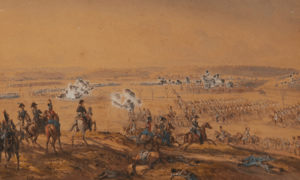Battle of Limonest facts for kids
Quick facts for kids Battle of Limonest |
|||||||
|---|---|---|---|---|---|---|---|
| Part of the Campaign of France of the Sixth Coalition | |||||||
 Charge of the 13th Cuirassiers Regiment at the Battle of Limonest, 20 March 1814, by Theodore Jung |
|||||||
|
|||||||
| Belligerents | |||||||
| Commanders and leaders | |||||||
| Units involved | |||||||
| Strength | |||||||
| 30,000-53,000, 112 guns | 20,000-23,000, 36 guns | ||||||
| Casualties and losses | |||||||
| 2,900-3,000 | 1,000-2,000 | ||||||
The Battle of Limonest was a key fight during the War of the Sixth Coalition. It happened on March 20, 1814, near the town of Limonest, France. In this battle, a large army of Austrian and Hessian soldiers, led by Prince Frederick of Hessen-Homburg, fought against French troops. The French forces were commanded by Pierre Augereau, who was a top military leader called a Marshal. The battle ended with a victory for the Austrian and Hessian forces.
Why the Battle Happened
While Napoleon was busy fighting the main Allied armies near Paris, another important part of the war was happening in southern France, near the city of Lyon. In January 1814, Austrian forces quickly took control of many areas. However, they couldn't capture Lyon itself.
By the middle of February, the French commander Augereau received more soldiers. He then managed to take back some towns. This made the Allied forces worried about their supply routes back to Germany. To protect these routes, the Allied commander, Schwarzenberg, sent a large number of troops to Prince Hessen-Homburg. These troops were meant to secure the southern part of their battle lines.
The Battle Itself
The fighting at Limonest was tough. The French soldiers were outnumbered by the Allied forces. Despite their brave efforts, the Allies pushed the French back. The French defenders had to retreat from a line of hills located north of Lyon. This defeat was a major moment in the War of the Sixth Coalition.
What Happened Next
After the battle, Lyon, which was the second-largest city in France at the time, was left open to the Allies. Because Prince Hessen-Homburg had so many more soldiers, he continued to push the French back. He captured Lyon just two days later, on March 22, 1814. This battle was a big step for the Allied forces in their campaign against Napoleon.

